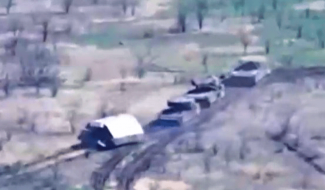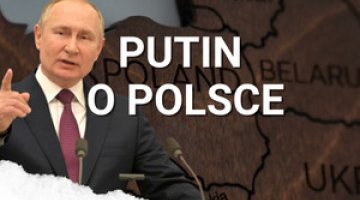Russian forces make tactical advances in several directions. Day 880 of the war

![]()
Over the past week, the Russian forces have made advances in several sections of the battlefront, mainly in the Donbas. They have taken the centre of Krasnohorivka and again pushed the defenders out of its southwestern suburbs, which the Ukrainian forces had recaptured in a counter-attack a week earlier. The Russian forces are continuing their advance towards Pokrovsk, where they have captured the town of Prohres, a local transport hub, and in the Toretsk agglomeration, where they have seized parts of Pivnichne and Zalizny and expanded their base of operations in the southern area of Niu-York. The Russian forces have also seized the eastern part of Maximilianivka, the last village that separated them from Kurakhovo. They have broken through the Ukrainian defences in the Seversk area, capturing Ivano-Darivka, a village located 6km south-east of this town. They have also breached the Ukrainian defence line south-east of Kupiansk and taken the village of Pishchane. Moreover, they have made minor advances in the Chasiv Yar area as they are attempting to capture a bridgehead on the western side of the Donets-Donbas canal.
By opening a new section of the battlefront in the Kharkiv area last May, the Russian army effectively dispersed the Ukrainian effort and made it easier for its own units to conduct offensive operations in other directions. Another contributing factor was the decision of the Ukrainian command, which was most likely inspired by the country’s top leadership, to move into offensive operations north of Kharkiv after the Russian advances in this area had been halted with the aim of pushing the invading forces back across the border into Russia. Ukrainian counter-attacks have so far failed to produce any significant results, but have forced the army to commit more forces, including units moved from other areas, which has weakened the Ukrainian defences in those sections. The fact that Russia has also been bringing more reinforcements, which are often new units that have not been fully formed and trained, has complicated the situation for the Ukrainian forces. A possible Ukrainian drawdown in the Kharkiv area to salvage the situation elsewhere could therefore create a direct threat to this city as well. Ukraine has almost entirely used up its reserves. Until it forms new units through its ramped-up mobilisation drive following legislative changes (assuming that Ukraine’s Western partners will move swiftly to equip these units), which will not take place until autumn at the earliest, the Ukrainian forces are unlikely to be able to regain their operational freedom, leaving the initiative with Russia.
On 18 July, Ukrainian border service spokesman Andriy Demchenko denied reports that Russian forces had breached the defence line in the Sumy region. He reported the activity of Russian sabotage and reconnaissance groups, whose tasks include determining the location of Ukrainian units and carrying out operations to weaken the effectiveness of Ukrainian defences.
![]()
The port infrastructure and military installations in the Odesa region remain a constant target for Russian missile attacks: new strikes were reported on 16, 18, 19 and 22 July. Russia has also launched more missile and drone strikes targeting the immediate support base of the Ukrainian forces, mainly in the Kharkiv and Mykolaiv regions. It has increased the use of its Iskander-M ballistic missiles for attacks in the frontline regions: for example, it has struck infrastructure and railway depots in the Kharkiv region on 20 and 22 July. We can expect Russia to increasingly launch its Iskanders from Crimea. Russian rockets and/or drones have struck energy facilities in the Sumy (20, 21, 22 and 23 July, in places such as Konotop and Shostka), Chernihiv (20 July) and Poltava (20 July in the Poltava and Myrhorod regions) oblasts. Between 16 and 23 July, the Russian forces reportedly used at least 42 missiles, including at least 12 Iskander-Ms; Ukraine claimed to have shot down three of these. According to Ukraine, Russia also used 79 Shahed-136/131 drones, 70 of which were destroyed. Ukrainian sources have reported that Russia used a new type of low-flying (20-30m) kamikaze drone, which was shot down on 20 July in the Kyiv area.
![]()
Further Ukrainian drone attacks have caused minor damage to the infrastructure in Krasnodar Krai. On 22 July, a fire occurred at the Tuapse refinery, but contrary to suggestions by Ukrainian military intelligence, this attack did not affect the facility’s operations. A day later, a ship was damaged in the port of Kavkaz; the Russian side reported casualties among the crew and the port’s staff. Attacks that mainly targeted airfields in the Rostov region (Millerovo on 20 July and Morozovsk on 22 July) were unsuccessful. Morozovsk was reportedly attacked by at least 47 drones out of a total of 76 used that day. Ukrainian attempts to strike the Kursk region (19 July) and Crimea (18, 19 and 23 July) with drones also failed. According to the Security Service of Ukraine, the attack on 18 July was intended to disrupt the organisation of exercises on Lake Donuzlav and destroy the installations of a coast guard unit’s base, but satellite imagery showed only traces of fire at the site of a neighbouring wind power plant.
![]()
On 19 July, during the European Political Community summit in the UK, President Volodymyr Zelensky announced that the Polish government had taken a positive decision “on a specific issue” that will enable Ukraine to receive F-16 fighter jets more quickly.
On 21 July, President Zelensky announced that a German Patriot air defence system had arrived in Ukraine. He did not specify whether this was a full battery, the handover of which Germany had confirmed at the NATO summit in Washington, or only its first components.
On 16 July, during Prime Minister Denys Shmyhal’s visit to Prague, Ukrainian Defence Industry (the successor to Ukroboronprom) and the Czech company Colt CZ Group signed two agreements worth a total of $6.5 million to launch the production of NATO-standard weapons and small arms ammunition in Ukraine. Česká zbrojovka will transfer technology and know-how and supply the equipment and components over the next three years to enable the assembly of CZ BREN 2 automatic carbines using the 5.56x45mm cartridge in Ukraine. Its direct contractor in Ukraine was not disclosed for security reasons. Ukroboronservice and the Czech company Sellier & Bellot agreed to cooperate in the production of various types of small-calibre ammunition, including NATO’s basic 5.56x45mm ammunition. Both agreements represent another step in the implementation of the agreements that were reached in September 2023 in Kyiv during the DFNC1 (the International Defence Industries Forum). Czech Prime Minister Petr Fiala further announced that 1,700 Ukrainian servicemen will receive training in the Czech Republic in 2024. So far, the Czech Republic has reportedly trained 6,000 Ukrainian soldiers.
France Info reported on 18 July that the French government is preparing a new military support package, its largest ever in terms of the number of combat vehicles. It will include 18 CAESAR howitzers, 24 ‘light tanks’ (probably more AMX-10RC armoured reconnaissance vehicles with 105mm cannon), 128 VAB light (two-axle) wheeled armoured personnel carriers, as well as anti-tank missiles, radars and trucks. In addition, in September France is set to start training 2,100 Ukrainian troops of the previously announced ‘French Brigade’. This process is scheduled to be completed in December. France Info’s sources in the French defence ministry did not specify when the upcoming arms package would arrive in Ukraine. It will likely be used to equip the ‘French brigade’.
On 18 July, Ukraine signed an agreement with Slovenia on security cooperation and long-term assistance. It stipulates that Slovenia, which has already provided Ukraine with 13 packages of military aid, will maintain its current level of support over the next 10 years, contribute to the training of the Ukrainian military within the framework of the EU’s EUMAM mission, and work to find sources of funding for Ukrainian defence projects. Slovenia also pledged €5 million in humanitarian aid.
On the same day, Ukraine concluded a similar agreement with the Czech Republic. A significant part of this document refers to cooperation in the military-technical sphere, primarily in the supply of small and large calibre ammunition (122 and 155 mm), the capabilities to manufacture small arms, light weapons and unmanned aerial vehicles. In addition, the agreement provides for strengthening the ammunition production capacity in both countries. The document emphasises that the Czech Republic’s partnership with the Dnipropetrovsk region for its reconstruction and sustainable development is a special form of cooperation between the two countries in the non-military sphere.
On 19 July, the defence ministers of the UK and Ukraine signed an agreement on credit support for the development of Ukrainian defence capabilities. It stipulates that UK suppliers will be able to obtain loans of up to £2 billion from the government in London to fund contracts with Ukraine. This amount is not final and may be increased in the future. Thanks to this form of support, the Armed Forces of Ukraine are expected to receive air defence systems and radar equipment by 2026 and to acquire the technology needed to manufacture artillery barrels and armoured vehicles. The loan repayment period is 15 years.
![]()
From 18 May to 17 July, more than 4.6 million Ukrainians updated their data in military commissions, including about three million through the ‘Reserve +’ application. On 18 July, Ukraine’s Deputy Minister of Economy, Vitaly Kindrativ, reported that businesses which have been declared as vital for the functioning of the economy have exempted some 800,000 persons subject to mobilisation from military service; this number could rise to 1.2 million.
On 18 July, President Zelensky approved Ukraine’s new maritime security strategy. It envisages the creation of the international Safe Black Sea platform with the participation of countries in the Black Sea region (excluding Russia), the Mediterranean, the Global South and other countries facing economic and food challenges as a result of Russia’s obstruction of freedom of navigation in the Black Sea. It also calls for deeper involvement of the UK and Norway-led Maritime Security Capability Coalition. Its aim is to develop Ukraine’s maritime capabilities and establish an ‘anti-mine coalition’ with the participation of NATO countries to carry out mine clearance of Ukrainian territorial waters and rivers after the war.
![]()
On 17 July, a 95-for-95 exchange of prisoners of war took place with the mediation of the United Arab Emirates. All those released were men: 88 privates and sergeants as well as seven officers; they included 13 Mariupol defenders. This was the 54th exchange of prisoners of war since 2022; a total of 3,405 people have now returned from Russian captivity.
In a poll by the Kyiv International Institute of Sociology (KIIS) that was published on 23 July, 55% of Ukrainian people expressed their opposition to any territorial concessions to Russia while 32% accepted such an option as a way of achieving peace and preserving the country’s sovereignty. Among those who expressed an opinion on this issue, 13% of respondents answered ‘difficult to say’. The survey shows that the percentage of those who accept territorial concessions has been increasing: it stood at 19% in late 2023 and at 26% in February this year.






